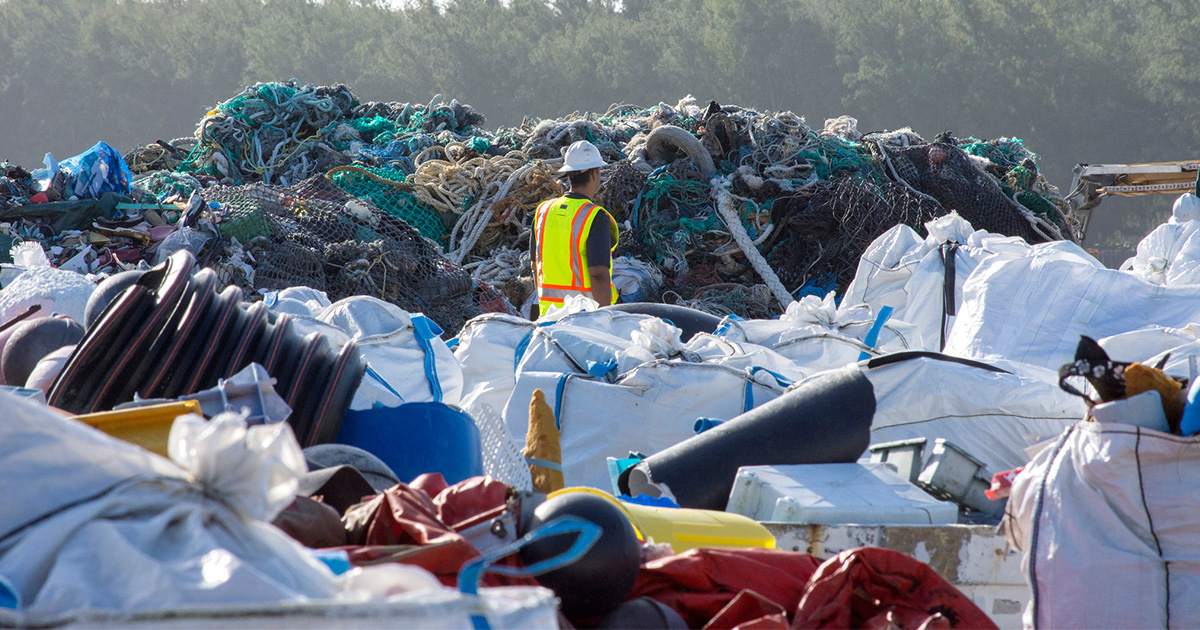

Plastic is moldable, durable, and its versatility means it’s everywhere and in everything from computers to medical devices. Its benefits are impossible to deny, but our relationship to this marvelous material is ultimately an unhealthy one. We undervalue and overuse plastic and in turn overdispose of it.
Our plastic addiction has created a dilemma that has made plastic an indispensable part of the modern world while simultaneously contaminating the oceans, choking landfills and even harming our health.
Each year humans send an estimated eight million metric tons of plastic out to sea. Our massive waste management problem means that pound for pound, humans are on pace to fill oceans with more plastic than there are fish by 2050.
Around the globe a million plastic bottles are bought and sold every 60 seconds, on average. This figure will spike another 20 percent by 2021. Last year, 480 billion plastic drinking bottles were consumed around the world. To put this into perspective, if placed end to end, the water bottles produced in 2016 would reach more than halfway to the sun.
Plastic is so pervasive that it has even made its way into the food chain and our drinking water. Scientists at Ghent University in Belgium calculated that the average European shellfish consumer eats up to 6,400 microplastics per year. Similarly, 83 percent of tap water samples in a recent investigation were found to contain microplastics.
Can #Plastic Ever Be Made Illegal? https://t.co/Jj6dja2Uaa @TurnTidePlastic @UNEP @storyofstuff #plasticpollution @Greenpeace @PlasticPollutes @NRDC @ewg
— EcoWatch (@EcoWatch) November 13, 2017
So, let’s break down some the staggering figures surrounding this ubiquitous material and what its presence means for the planet:
- Since 2000, humans have produced as much plastic as in all previous years.
- Fewer than half of the bottles bought in 2016 were collected for recycling and only seven percent of those collected were turned into new bottles.
- 10 river systems carry more than 90 percent of the plastic that ends up in the world’s oceans.
- In 2016, Coca Cola increased its production of single-use bottles by more than a billion, according to an analysis by Greenpeace.
- Humans consume nearly 20,000 plastic bottles every second.
- Coca Cola alone produces 3,400 bottles a second.
- Half of all plastic becomes trash within a year.
- A recent study found that plastic was found in nearly a third of UK-caught fish.
- Even uninhabited islands in the pacific are polluted by plastic. In 2017, marine scientists found that Henderson Island, a tiny island in the South Pacific, was covered by roughly 18 tons of plastic.
- More than 200 animal species have been documented consuming plastic, including turtles, whales, seal, birds and fish.
- 90 percent of seabirds eat plastic and nearly every seabird will consume it by 2050, according to a 2016 study.
- The U.S. has the world’s highest rate of microplastic water contamination—94.4 percent of tap water samples contained plastic fibers, which are known to contain and absorb toxic chemicals.
- Europe, which was found to have the lowest rate of microplastic water contamination, had a contamination rate of 72.2 percent.
- In 2017, the European chemicals agency decided that BPA was an “endocrine disruptor.”
- More than 90 percent of the world’s population have traces of BPA in their urine sample.
- Although we know about the pervasiveness of plastic, very little is understood about the effects of its consumption, a phenomenon that nearly all humans are a part of.
- In the Los Angeles area alone, 10 metric tons of plastic fragments—grocery bags, straws and soda bottles—are carried into the Pacific Ocean every day.
- Billions of pounds of plastic can be found in swirling convergences in about 40 percent of the world’s ocean surfaces.
- The production of plastic uses around eight percent of the world’s oil production, according to estimates.
- The heart of the Great Garbage Patch in the Pacific Ocean is thought to be around 386,000 square miles, with the periphery spanning a further 1,351,000 square miles. According to the UN Environmental Programme, the patch is becoming visible from space.
What can be done to scale back this problem?
- Pressure politicians. While day-to-day actions are important, ultimately macro policies are needed to make meaningful change. Governments should be funding research into microplastics and regulating and incentivizing changes in plastic production and consumption.
- Complain to retailers. Pressure retailers to do away with over-packaging.
- Support plastic bag bans, polystyrene foam bans and bottle recycling bills.
- Use natural clothing fiber rather than synthetic clothing, as synthetic cloth releases plastic fiber in every wash cycle.
- Choose to reuse. Neither plastic shopping bags nor plastic water bottles can be easily recycled.
- Deposit return schemes are highly effective ways to reduce plastic bottle waste. In Germany, where a bottle-return program is in place, nearly 98 percent of plastic bottles are returned.
- Recycle. If you must use plastic, try to choose #1 (PETE) or #2 (HDPE), which are the most commonly recycled plastics.
- Avoid plastic bags and polystyrene foam as both typically have very low recycling rates.
- Seek out alternatives to the plastic items that you rely on.

 233k
233k  41k
41k  Subscribe
Subscribe 